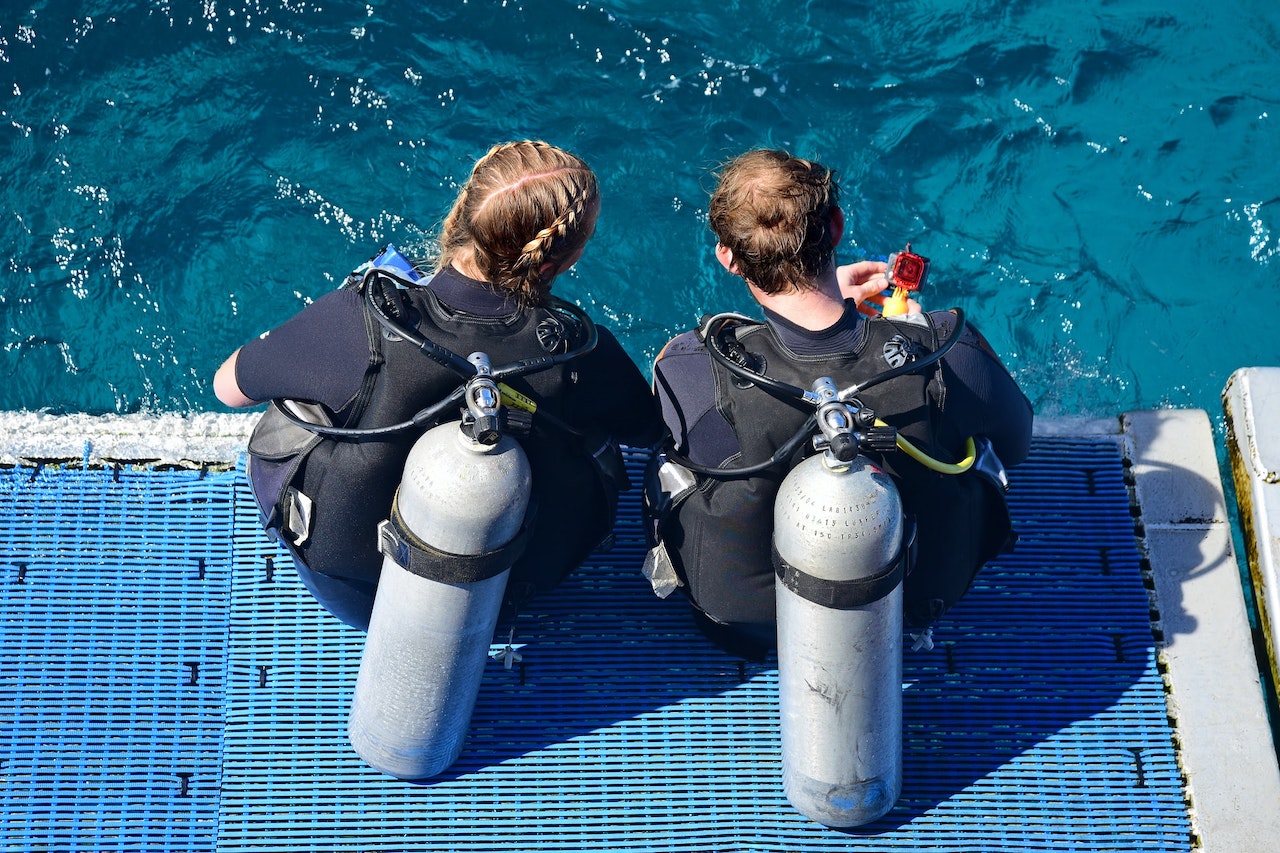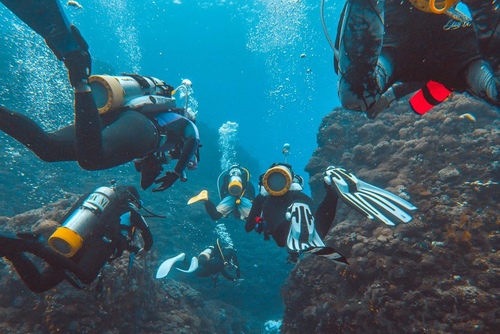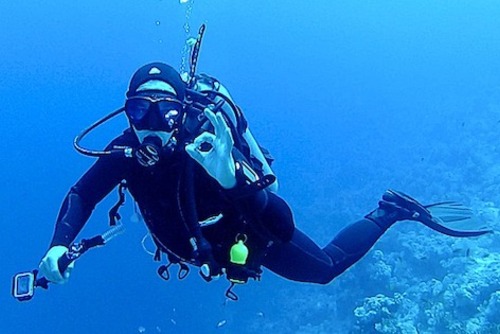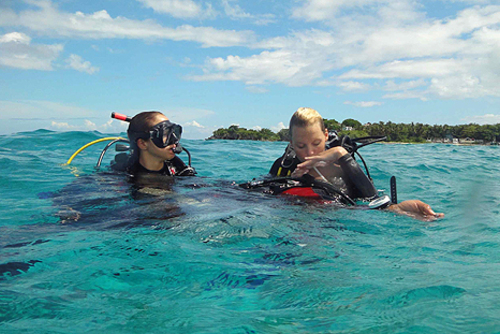Preparation is key to ensuring a safe and enjoyable experience for first-time divers and a significant part of preparation involves acquiring the necessary scuba gear. Each piece of equipment plays a vital role in underwater safety, comfort, and performance.
From masks and fins to tanks and regulators, having the right gear ensures first-time divers can confidently dive without any worries.
In this guide we will explore the must have scuba diving equipment, focusing on the purpose and significance of each item for a successful dive.
1. Choosing the Right Dive Mask for Visibility
The dive mask is one of the paramount scuba gear set pieces, providing clear underwater vision and protecting the eyes from saltwater.
Unlike goggles, a dive mask creates an air pocket in front of the eyes, allowing divers to see clearly while submerged. Selecting a mask that fits comfortably and securely is crucial for first-time divers. The fit of the mask is the primary consideration, as a poorly fitting mask can cause leaks and discomfort during a dive.
Divers should try on several masks to find one that creates a proper seal against the face. This is done by placing the mask on the face without the strap, inhaling gently through the nose, and ensuring it stays in place. The lens material also matters. Tempered glass is preferred for its durability and resistance to cracking under pressure.
Some masks propose side windows for a wider field of view or prescription lenses for divers who wear glasses. By choosing the right dive mask, first-time divers can enjoy unobstructed views of the underwater environment while staying comfortable throughout their dive.
2. Selecting Fins for Efficient Movement
Fins are essential for efficient underwater movement, allowing divers to navigate easily and conserve energy. They come in various styles, each designed to accommodate different diving conditions and preferences.
For first-time divers, choosing fins that are comfortable and suited to their needs is essential. Full-foot fins are popular for warm-water dives, as they fit snugly over the foot and are lightweight. They are easy to use and ideal for beginners who plan to dive in tropical locations.
On the other hand, open-heel fins are paired with dive boots and are suitable for colder waters or more rugged diving conditions. Their adjustable straps ensure a secure fit, even when wearing thicker wetsuits or dry suits. Blade fins offer powerful propulsion and are well-suited for divers who expect to encounter strong currents, while split fins reduce strain on the legs and are ideal for those seeking a gentler swimming experience.
First-time divers can enjoy smooth and efficient underwater movement by selecting fins that align with their diving environment and comfort level.
3. Understanding the Importance of a Wetsuit
A wetsuit is a critical component of scuba gear, providing thermal insulation, buoyancy, and protection from marine life or sharp objects.
For first-time divers, selecting a wetsuit that fits well and matches the water conditions is paramount for a comfortable and safe dive. Wetsuits arrive in different thicknesses, typically measured in millimeters, to suit various water temperatures. Thicker wetsuits provide more insulation and are suitable for colder waters, while thinner wetsuits are ideal for warmer climates.
A proper fit is vital, as a wetsuit that is too loose will allow water to enter and reduce its effectiveness in keeping the diver warm. In addition to warmth, wetsuits propose protection from potential scrapes, stings, or cuts while exploring underwater environments. They are made from neoprene, a material that provides flexibility and durability.
Choosing the right wetsuit ensures comfort and protection, allowing them to focus on the wonders of the underwater world.
4. Breathing Comfortably with a Regulator
The regulator is a key piece of scuba gear that allows divers to breathe safely underwater. It reduces the high pressure of the air in the tank to a breathable level and delivers it to the diver through a mouthpiece.
Comprehending the components and functionality of a regulator is paramount for a safe and enjoyable experience. A regulator system typically includes a first stage, which connects to the air tank, and a second stage, the mouthpiece.
Many systems also include additional components, such as an octopus (a backup regulator) and a submersible pressure gauge (SPG) to monitor air supply. Some systems integrate a dive computer for added convenience. Choosing a regulator that is reliable, easy to use, and comfortable is critical. It should provide smooth airflow and fit securely in the diver’s mouth.
By selecting a high-quality regulator and familiarizing themselves with its operation, first-time divers can breathe easily and focus on their underwater adventure.
5. Ensuring Safety with a Buoyancy Control Device
The buoyancy control device (BCD) is a paramount part of scuba gear that enables divers to control their buoyancy underwater. It enables them to float, sink, or hover effortlessly, making navigating and conserving energy easier.
Learning to use a BCD effectively is a key skill for first-time divers. A BCD is typically a jacket or vest with an air bladder that can be inflated or deflated using a control mechanism.
This adjustment helps the diver achieve neutral buoyancy, which is critical for maintaining stability and minimizing the impact on the underwater environment.
When selecting a BCD, first-time divers should prioritize comfort, fit, and ease of use. It should provide enough lift to support the diver and their gear while fitting snugly without restricting movement. Many BCDs also enclose integrated weight systems, reducing the demand for separate weight belts and enhancing comfort. By mastering the usage of a BCD, divers can enhance their control and confidence underwater.
Equipping yourself with the right scuba gear is vital for first-time divers preparing to explore the underwater world. From masks and fins to wetsuits, regulators, and BCDs, each item on the checklist serves an important purpose in ensuring safety, comfort, and enjoyment during the dive.
By understanding the functionality and selecting gear that aligns with their needs and diving environment, beginners can build a solid foundation for their underwater adventures.
With proper preparation and quality equipment, first-time divers can immerse themselves in the beauty of the ocean with confidence and excitement, creating memories that last a lifetime.








